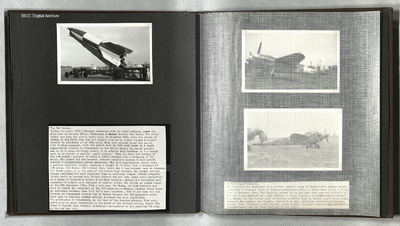V-2
Title
V-2
Description
A view of a V-2 mounted on a launching trolley. A caption describes the development of the rocket.
Coverage
Language
Type
Format
One b/w photograph on an album page
Publisher
Rights
This content is available under a CC BY-NC 4.0 International license (Creative Commons Attribution-NonCommercial 4.0). It has been published ‘as is’ and may contain inaccuracies or culturally inappropriate references that do not necessarily reflect the official policy or position of the University of Lincoln or the International Bomber Command Centre. For more information, visit https://creativecommons.org/licenses/by-nc/4.0/ and https://ibccdigitalarchive.lincoln.ac.uk/omeka/legal.
Identifier
PThomasAF20080023
Transcription
[Photograph]
The V-2 Rocket.
During the early 1930’s Germany commenced work on rocket motors, under the direction of Captain Walter Dornberger & [deleted] Werher [/deleted] Wernher Von Braun. The first rocket was used for static tests only. In December 1934, from the island of Borkum in the North Sea, two A-2 rockets fuelled by liquid oxygen & alcohol climbed to altitudes of of [sic] 7900 feet. With this success money was poured into further research, with the result that in 1935 work began on a large experimental station at Peenemunde on the Baltic coast. The major project was to be a large artillery rocket, & to achieve this features of the design were to be tested on smaller scale rockets. Thus was born the concept of the A-4 rocket, designed to carry a 2205lb warhead over a distance of 270 miles. The rocket did not however, achieve immediate success & much modification and strengthening proved necessary. The tird [sic] experimental rocket made a perfect ballistic flight, reaching a height of 53 miles over a distance of 118 miles, the date – 3rd October 1942. World War II had already been in progress for three years, & in the eyes of the German High Command, the rocket had now become something far more important than an artillery weapon. Before adequate trials could be carried out, Hitler ordered the A-4 into large scale production as a means of bombarding London & the Home Counties. Mobile A-4 batteries were organised & rockets were deployed at coastal sites. The attack on London began on the 8th September 1944, from a site near the Hague. At last Goebbels was able to reveal the existence of the V-2 Retaliation Weapon, against which there no available defence. Some 4320 V-2’s were launched. Had it not been for the attacks on Peenemunde carried out by Bomber Command the V-2 programme would have come to fruition months earlier, & caused far more casualties.
The principals at Peenemunde, in the face of the Russian advance, fled west, preferring to place themselves in the hands of the Western Allies. Werner Von Braun & Captain (now General) Dornberger surrendered to the American 7th Army on the 2nd May 1945.
The V-2 Rocket.
During the early 1930’s Germany commenced work on rocket motors, under the direction of Captain Walter Dornberger & [deleted] Werher [/deleted] Wernher Von Braun. The first rocket was used for static tests only. In December 1934, from the island of Borkum in the North Sea, two A-2 rockets fuelled by liquid oxygen & alcohol climbed to altitudes of of [sic] 7900 feet. With this success money was poured into further research, with the result that in 1935 work began on a large experimental station at Peenemunde on the Baltic coast. The major project was to be a large artillery rocket, & to achieve this features of the design were to be tested on smaller scale rockets. Thus was born the concept of the A-4 rocket, designed to carry a 2205lb warhead over a distance of 270 miles. The rocket did not however, achieve immediate success & much modification and strengthening proved necessary. The tird [sic] experimental rocket made a perfect ballistic flight, reaching a height of 53 miles over a distance of 118 miles, the date – 3rd October 1942. World War II had already been in progress for three years, & in the eyes of the German High Command, the rocket had now become something far more important than an artillery weapon. Before adequate trials could be carried out, Hitler ordered the A-4 into large scale production as a means of bombarding London & the Home Counties. Mobile A-4 batteries were organised & rockets were deployed at coastal sites. The attack on London began on the 8th September 1944, from a site near the Hague. At last Goebbels was able to reveal the existence of the V-2 Retaliation Weapon, against which there no available defence. Some 4320 V-2’s were launched. Had it not been for the attacks on Peenemunde carried out by Bomber Command the V-2 programme would have come to fruition months earlier, & caused far more casualties.
The principals at Peenemunde, in the face of the Russian advance, fled west, preferring to place themselves in the hands of the Western Allies. Werner Von Braun & Captain (now General) Dornberger surrendered to the American 7th Army on the 2nd May 1945.
Collection
Citation
“V-2,” IBCC Digital Archive, accessed November 5, 2024, https://ibccdigitalarchive.lincoln.ac.uk/omeka/collections/document/23288.
Item Relations
This item has no relations.

